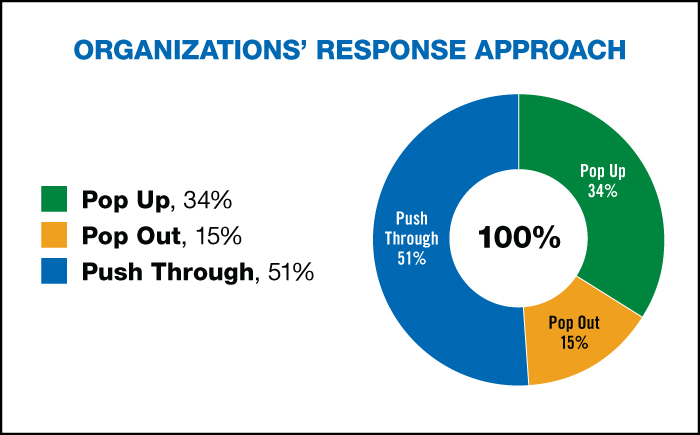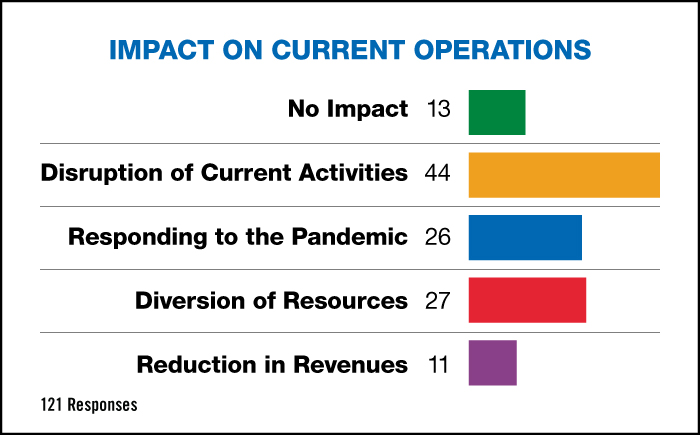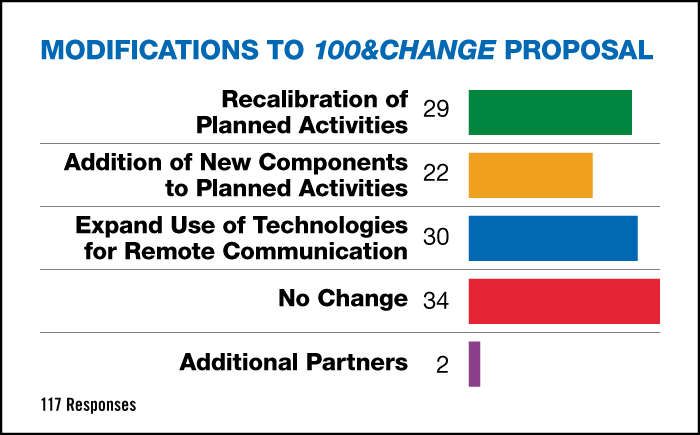Cecilia Conrad, Managing Director of 100&Change and CEO of Lever for Change, shares a snapshot of how the Top 100 100&Change applicants are impacted by COVID-19.
As measures to combat the spread of COVID-19 have disrupted lives around the world, we are constantly reminded of how much we have in common—a shared need to grieve, a longing to be physically close to others, a willingness to pitch in and help others, and communal gripes: how do you wear a mask without fogging up your glasses? But, much of our experience is particular to where we work; where we live; and our social, economic, and cultural identities. We expect that the same is true for the businesses and nonprofits who are participants in 100&Change.
For the 100&Change selection process, COVID-19 poses specific challenges. Competition submissions for the single $100 million grant were evaluated from October-January 2019, long before most of us were thinking about the immediate or long-term consequences of a pandemic. Recognizing that the environment in which their proposals were drafted has changed, we offered the Top 100 applicants an opportunity to share with us their early stage thinking about the potential impact of COVID-19 on their 100&Change projects. We sent a survey in mid-March asking three questions:
- How has the pandemic impacted, or do you anticipate it impacting, the operations of the lead organization and its partners?
- What changes, or anticipated changes, would you make to your proposal due to the impacts highlighted above?
- Please review the Barrier Assessment/Risk Mitigation response provided in your original proposal and update it, if needed.
The responses provide a snapshot taken at a moment in time of a cross-section of the social sector. The answers to these three questions might be very different if posed two months from now or even two weeks from now. As of April 24, 2020, we have received 100 survey responses.
To provide a broad overview of the responses, I borrowed a taxonomy used by Jim Bildner, CEO of the Draper Richards Kaplan Foundation. Bildner groups pandemic responses of foundation clients into three categories: Pop-Up, Pop-Out, and Push-Through. A team is popping up when it is expanding its current activities in response to increased demand for its services. The Pop-Up category includes many teams that are on the frontlines of addressing socioeconomic consequences of the pandemic like hunger, homelessness, domestic violence, etc. A team is popping out when it is repurposing its infrastructure or its human capital to respond to the crisis. Among the Top 100, there are several examples of popping out: robust and trustworthy supply chains built to supply eyeglasses or agricultural supplies being repurposed to deliver COVID-19 needs like personal protective equipment.
A team is pushing through when it maintains focus on its original mission and engages in activities to assure that it can survive and continue to work on critical social issues in a post-pandemic world. The majority of the Top 100 teams fall into the Push-Through category.


Next we look at responses to the specific set of questions we posed. Teams might fit into one or more categories, so the totals will add up to more than 100.
Less than 15 percent of our respondents identified a reduction in revenues—donations or earned revenues—as an impact on current operations. By comparison in a recent survey of over 450 nonprofits by Catchafire, over 40 percent of nonprofits reported a decrease in donations, and over 50 percent reported a decrease in earned revenues. The lower percentage probably reflects the prevalence of large nonprofits and universities among the Top 100. (For a fuller description of the highest-scoring proposals in 100&Change, read: The Top 100: What Sets Them Apart?) Yet, even large organizations speculated that there might be future reductions in philanthropic and government support if resources flock to pandemic response. Roughly the same number of teams reported impacts, either because organizational resources have been diverted to the pandemic, or because the team itself was directly responding to the pandemic.
Over 50 percent of teams reported a disruption of current activities because of self-quarantine restrictions, social distancing, and travel restrictions. For some, their local partners lack the connectivity required for virtual communications; for others, it is simply an inadequate substitute for in-person interactions.
Even so, organizations are experimenting with technologies that facilitate remote communications. Twenty-nine organizations described plans to expand the use of these technologies in their projects. There are a couple of examples of organizations that are using the pandemic as an opportunity to experiment with the virtual delivery of services, accumulating data to assess whether virtual delivery could be a long-term component of their strategy.

Slightly over 20 percent of the teams plan to add new components to their projects in response to the pandemic. For example, several projects will incorporate pandemic-relevant content into curriculums; others plan to broaden the purposes of health infrastructure that would be created with the grant.
Probably the most difficult task that we gave respondents was our request that they reconsider their original analysis risks and barriers. There is still a lot of uncertainty around the pandemic—how long will it last, whether it will resurge next year, how businesses and nonprofits will be able to rebound. Many questions can’t be answered at this moment in time. A few applicants outlined several possible scenarios. Most assumed that we would reach a post-pandemic normal by mid-2022. We sorted their assessments of risk and barriers into three buckets: Heightened Risk, 50; No Significant Change, 36; and Possibly Less Risk, 8 projects. (Five projects did not respond directly to the question about risk.)
We will use the responses in three ways. First, this information, along with the original application materials, the Peer-to-Peer reviews, an evaluation by an external panel of judges, and the technical reviews will inform the MacArthur Board of Directors deliberations to select the 100&Change finalists. We anticipate announcing the finalists in mid-summer. Second, this data will inform Lever for Change’s efforts to offer supportive services and technical assistance to the members of the Bold Solutions Network, a collection of highly-vetted “bold solutions” that emerge from open competitions managed by Lever for Change. Finally, we plan to conduct more in-depth analyses of the content of these responses to share with the field of philanthropy.



